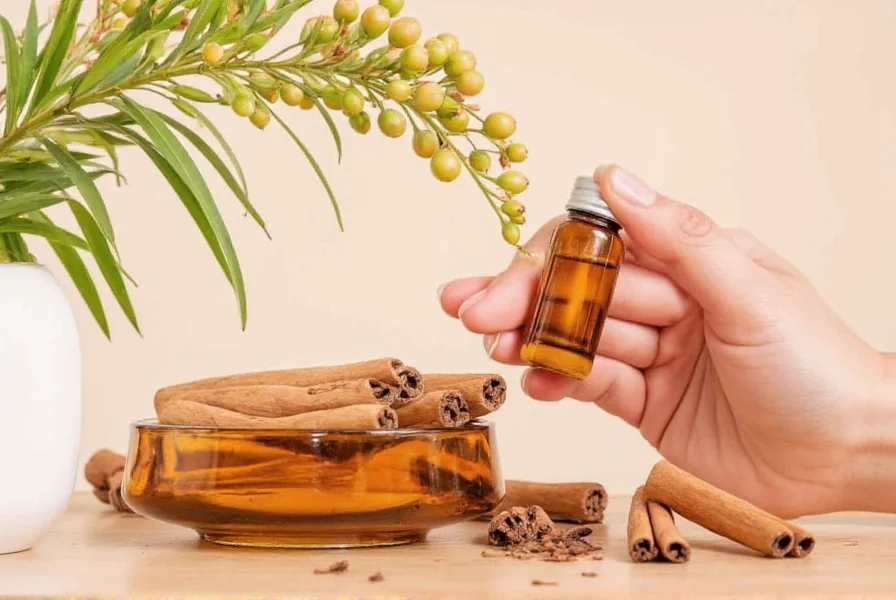Cinnamon oil stands as one of nature's most potent essential oils, with scientific research validating many traditional uses while revealing important safety considerations. This comprehensive guide examines the evidence-based applications, chemical properties, and critical safety protocols for responsible use of this powerful botanical extract.
Understanding Cinnamon Oil Composition
Cinnamon oil exists in two primary forms: Ceylon cinnamon oil (Cinnamomum verum) and Cassia cinnamon oil (Cinnamomum cassia), with significant chemical and safety differences between them. Ceylon cinnamon oil contains 50-70% cinnamaldehyde with lower coumarin levels (0.004%), making it safer for limited topical applications. Cassia oil, more commonly available, contains 70-90% cinnamaldehyde but significantly higher coumarin (up to 5%), which poses liver toxicity risks with prolonged exposure.

Documented Benefits and Scientific Evidence
Research published in the Journal of Agricultural and Food Chemistry confirms cinnamon oil's significant antimicrobial properties against foodborne pathogens like E. coli and Salmonella. A 2021 Phytotherapy Research meta-analysis noted cinnamon oil's potential for supporting healthy blood glucose metabolism through enhanced insulin sensitivity, though human clinical trials remain limited.
Unlike many essential oils, cinnamon demonstrates notable anti-inflammatory effects through inhibition of NF-kB pathways, according to laboratory studies. However, these cinnamon oil benefits and uses must be balanced against its high dermal sensitization potential.
Safety Protocols and Proper Usage
Cinnamon oil ranks among the most irritating essential oils due to its high cinnamaldehyde content. The International Fragrance Association recommends maximum dermal concentrations of 0.05% for leave-on products and 0.2% for rinse-off formulations. For home use, proper cinnamon oil dilution ratio requires:
| Application Type | Dilution Ratio | Carrier Oil Volume | Cinnamon Oil Drops | h>
|---|---|---|---|
| Adult topical use | 1% | 1 oz (30ml) | 6 drops |
| Aromatherapy diffusion | N/A | 100ml water | 1-2 drops |
| Cleaning solutions | 2% | 1 cup water | 10 drops |
Never apply undiluted cinnamon oil to skin. Conduct patch testing 24 hours before broader application. Cinnamon essential oil safety guidelines strictly prohibit use with infants, children under 6, pregnant or breastfeeding women, and individuals with liver conditions due to coumarin content.
Practical Applications and Limitations
For cinnamon oil for aromatherapy, use only in well-ventilated spaces with limited diffusion time (15-20 minutes maximum). Its warming, spicy aroma can support focus during work sessions but may cause respiratory irritation in sensitive individuals.
When considering how to use cinnamon oil for skin, remember it's generally inappropriate for facial applications due to high irritation risk. Some formulations use trace amounts (0.1% or less) in foot care products for antimicrobial benefits, but even these require extreme caution.
Many DIY enthusiasts mistakenly confuse cinnamon oil vs cinnamon bark oil - they're the same product. True cinnamon leaf oil (from Cinnamomum verum leaves) contains eugenol instead of cinnamaldehyde and presents different safety profiles.
Storage and Quality Assessment
Proper cinnamon oil storage recommendations include amber glass bottles with tight seals, stored in cool, dark places. Exposure to light and air accelerates oxidation, increasing skin irritation potential. Shelf life typically ranges from 12-18 months when stored properly.
When evaluating quality, look for GC/MS (gas chromatography/mass spectrometry) reports showing cinnamaldehyde content between 50-90% depending on variety. Reputable suppliers provide botanical Latin names (Cinnamomum verum vs. Cinnamomum cassia) and country of origin. Avoid products labeled simply as "cinnamon oil" without species specification.

Common Misconceptions and Risks
Despite popular claims, cinnamon oil for weight loss lacks substantial scientific support. Some dangerous online protocols suggest applying highly concentrated cinnamon oil to the abdomen for "fat burning," which frequently causes severe chemical burns.
Many pet owners mistakenly believe is cinnamon oil safe for pets - it is not. Cats lack glucuronyl transferase enzymes needed to metabolize cinnamaldehyde, making even diffused cinnamon oil potentially fatal. Dogs show similar sensitivity, with documented cases of liver damage from exposure.
The cinnamon oil antimicrobial properties that make it useful in cleaning solutions don't justify internal consumption. Ingesting even small amounts (1-2ml) of undiluted cinnamon oil can cause mucosal burns, vomiting, and liver damage due to coumarin toxicity.











 浙公网安备
33010002000092号
浙公网安备
33010002000092号 浙B2-20120091-4
浙B2-20120091-4